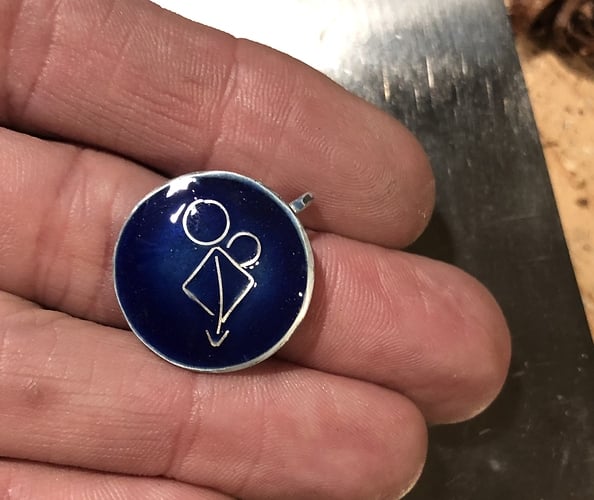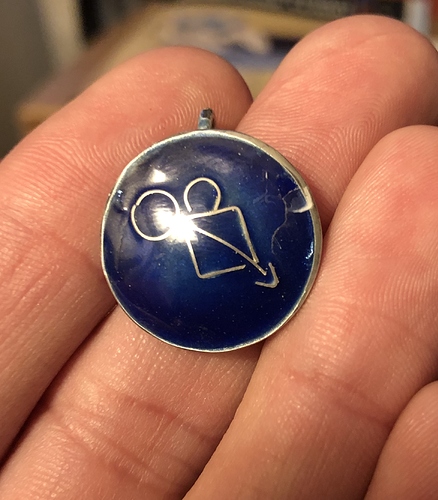I have made a medallion for a customer of mine and I think it well for a first try. The problem is I let it sit in my shop and it developed cracks just sitting on the shelf. The longer it sits the bigger the crack seems to get.
Did you counter enamel the “backside”. Most cracking problems occur when there is not counter enamel on the backside of you piece. Also, did you use any wetting agent that you shifted your enamel on that was not dried thoroughly?
Tony …from North Carolina
Is that bezel the cause? It may have cracked on setting it. It’s glass, brittle and fragile, so it can break easily when pushing the bezel, and enlarge with time and temperature to be visible. Are you an experienced enameler? You may know, but leaded and unleaded types don’t play well if you put unleaded on top of leaded. I did that once when getting back to it after a long hiatus, and it looked like that. Need to remove enamel and regrind off the remnants, to save this if so.
Thank you so much for the pointers. I am very much a beginner. The ring in the edge just looks like a bezel. It is a ring for the enamel to butt against. I think the problem might be the back enamel. I only put two coats on the back. I’m not sure if the clear I used to finish was leased or not I will have to check it out. So my plan is to add more back enamel and grind out the cracked area and attempt to repair it. Nothing else it’s a learning experience. Thanks again.
Are you enameling on fine silver?
Any solder used on the ring around the edge?
Maybe it is just the angle, but that second picture sure looks like the edge of the outer wall took a hit from a hammer.
How thick is the back plate and what wire did you use for the outer lip of the medallion? If the back plate is thick enough, I have not needed to use enamel on the backside of the object to counter the forces on the front side.
One thing you didn’t mention is your experience level with enamel.
How deep is the design to the backplate? How many layers of enamel did you use? Putting too thick of a layer of enamel at one time can cause cracks and crazing.
_*******_I was enameling sterling and have since learned that fine silver is better. And yes there was solder used to attach the ring to the base.
I am very much a beginner. I believe I used 20g for the base plate. After an initial light coating I wet packed it.
I am thinking that I need to keep much better notes on the pieces I make.
I ground out all the damaged areas and wet backed it and gave it a good heating and then added two more coats if backing. I can still see a slight crack by the arrow. emphasized text
Hi,
I am not an experienced enamelist, but your issue reminds me of the one I had while making a very heavy signet ring. (the shank was not hollowed out) (it weighed about an ounce!)
there was a flat topped dragon symbol on top, and a 1.0mm border/ frame/ bezel at the edges, with the background around the dragon recessed approximately 1.0mm, so, the enamel was approximately 1.0 thick.
the ring was created in Matrix CAD and then printed. I made all the recessed “corners” and “bends” very slightly radiused, so no sharp corners…
all vertical walls were straight up 90 degrees (good? bad?)
my enamel kept cracking over time.
(unleaded, opaque, royal blue color)
My issue was resolved after I did three things…not technically sure why…:
-
reduced the height of the top recess from 1.0mm to .80mm, by grinding down the top surface…
-
I accidentally left the piece in the kiln for what I thought to be “too long” (but probably was the “correct” time(!). (the enamel was glowing orange!) (maybe prior firings were not hot/ long enough…maybe I was not getting the whole thickness hot deep enough…)
-
I created a “heat cave” to very, very, very slowly cool down the piece
I put the enameled piece on a soldering block, covered it with a metal dog food bowl, and then covered that with oven mitts and a towel…and then just left it alone for a few hours…
I cannot explain technically, but basically the metal and the enamel expand and contract at different rates…the metal can exert pressure on the enamel…the enamel can pull away from the metal…both can be happening at the same time, at different rates…depending on the thickness of the metals(bottom, sides), (also vertical walls and sharp bends are not the greatest idea, I think) thickness of the enamel (too thick, too thin…)
I “think” the very, very, very, very slow cooling kind of helps to make these changes happen slower(?) and less violently(?)
just my morning musings…
Julie

